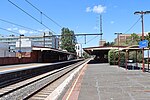Glenferrie Oval
Defunct Australian Football League groundsSports venues in MelbourneUse Australian English from January 2018Victorian Heritage Register

Glenferrie Oval is an Australian rules football stadium located in Hawthorn, a suburb of Melbourne, Victoria, Australia.It is the historic home of, and is synonymous with, the Hawthorn Football Club, who played there from 1903 and as a VFL/AFL club from 1925–1973, and retained the ground as an administrative and training base until 2006. Hawthorn moved to a redeveloped Waverley Park early in 2006 in preparation for the 2006 AFL season.
Excerpt from the Wikipedia article Glenferrie Oval (License: CC BY-SA 3.0, Authors, Images).Glenferrie Oval
Linda Crescent, Melbourne Hawthorn
Geographical coordinates (GPS) Address Website External links Nearby Places Show on map
Geographical coordinates (GPS)
| Latitude | Longitude |
|---|---|
| N -37.820555555556 ° | E 145.03277777778 ° |
Address
Glenferrie Oval
Linda Crescent
3122 Melbourne, Hawthorn
Victoria, Australia
Open on Google Maps





